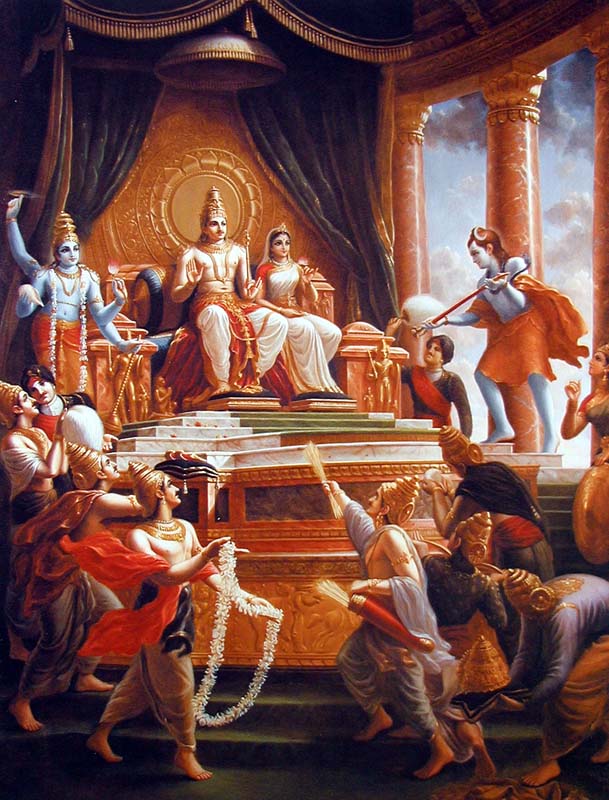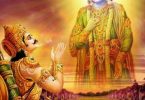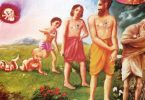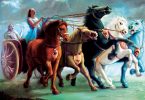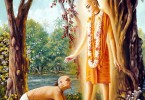Question: How to understand Yamaraja Having Four Abodes?
Answer by Romapada Swami:
We learn from Narada Muni that elevated associates of the Lord exist simultaneously in different realms, by the Lord’s arrangement, to allow them to serve Him in different ways. [BB 3.5.51-54]
This principle holds for Yamaraja, as well.
- Hellish Planets
Yamaraja is primarily associated with his position as the Lord of Death. He rules in the Naraka realm where sinful persons are taken for punishment, resulting from their sins.
The tortures described as hellish (SB Canto 5, Chapter 26) occur in the Narakaloka planets. While SB 5.26.7 indicates “Some authorities say that there is a total of twenty-one hellish planets, and some say twenty-eight”, it is stated at the end of Chapter 26 that the number of hells is “hundreds and thousands.”
The lowest of the 14 planetary systems, Patalaloka, is situated 30,000 yojanas above the Garbha Ocean. It is within that space between the Garbhodaka ocean and Patala that the hellish planets exist, on the southern side of the universe – the direction ruled by Yamaraja.
Yamaraja rules over these hellish planets. Interestingly, it seems that of all the varshas on Bhu-mandala, only Bharata varsha exists in the southern direction. As such, it is only from here that one may go to Yamaraja’s hellish abode.
2. Pitrloka
Yamaraja is the king of Pitrloka {SB 5.26.6}, with its capital city named Samyamani. Similar to the hellish region, SB 5.26.5 places Pitåloka in the region between the Garbhodaka Ocean and the lower planetary systems. However, while it is below the earth, Pitrloka is not part of the hellish region, even though the two regions are located nearby each other. {“Pitåloka is also located in this region between the Garbhodaka Ocean and the lower planetary systems. All the residents of Pitåloka, headed by Agniñvättä, meditate in great samädhi on the Supreme Personality of Godhead and always wish their families well.”}
Those who live in Pitr-loka are generally fruitive workers who have been elevated to that place because of their pious activities. Additionally, they need male descendants to continue regular offerings to their forefathers so that the pitrs can survive there nicely. If all goes well, when their time there is up, they return to their own dynasty. If things do not go well, that is if the offerings cease, then they become tormented due to their descendant’s neglect of dharma and unhappy with the impiety. After some time, when they are disfigured by suffering, Yamaraja feels compassionate for them and they may be given posts as Yamadutas. As they were suffering because their descendants gave up dharma, they are very keen to arrest sinful people.
The attachment of these inhabitants to the karma kanda rituals and proper performance of duties can be seen in their prayers to Lord Nrsimhadeva. In SB 7.8.44, they first glorify the Lord as the maintainer of religious principles and then say how Hiranyakasipu stole and enjoyed the offerings of the sraddha ceremonies.
Pious people go to Pitrloka, and impious people go to hell. Yamaraja presides over both and gives them their just rewards, hence he is associated with both. Those who are pious have one type of experience when they are ruled by him, and those who are sinful have another, which is described in the Srimad Bhagavatam Canto 5 Chapter 26.
Interesting:
*The inhabitants of Pitrloka experience day/night that are equal to one month for us. This can be seen in Srimad Bhagavatam 5.22.5 and 5.22.9, wherein day and night there is measured according to the waxing and waning of the moon. However, the moon is considered to be higher than the earth, whereas Pitr-loka is lower than the earth according to the vertical layout given in the Puranas. The moon is part of devaloka, which is obtained via the northern path of the sun, whereas Pitrloka is obtained by the southern path of the sun.
Experience of day/night are the opposite above and below the earth.
*Both Yamaraja (son Vivasvan and Sanjna) and Aryama (one of the 12 sons of Aditi, who took the post of Yamaraja for 100 years during his absence when cursed by Manduka Muni to become a sudra – i.e. Vidura) are associated with Pitrloka.
3.Atop Mount Sumeru
Part of the Heavenly realm, Yamaraja serves as one of the eight dik-pālas or guardians of the eight directions, also known as “subordinate governors of the planetary systems” [SB 5.16.29]. His abode here is also known as Samyamani (the same name used within Pitrloka).
4. Atop the circular Manasottara Mountain
Manasottara Mountain is in the middle of Puskaradvipa, the 6th island of Bhumandala. In the chariot of the sun-god, the sun travels on the top of the Manasottara Mountain in an orbit called the Saàvatsara, moved by kala-cakra.
Atop Manasottara Mountain, situated in the southerly direction from Sumeru, Yamaraja also resides in Samyamani. This particular abode of Yamaraja is part of Bhumandala, the earthly realm.
Interesting:
There is an interesting Puranic statement, indicating that the residents of Puskaradvipa can see the hells in the sky. So, there may be some connection with Samyamani and Narakaloka; however, the general understanding is that the hellish planets are below Patalaloka and just above the Garbhodaka Ocean. As such, this statement may be indicating that Puskaradvipa also exists in a globe form, with those in the outer part of the island being in the southern hemisphere and would be able to see the hellish planets below the earth. This can be explained if Puskara dvipa also exists as a globe, aside from a ring-shaped circular island.
Also, one additional evidence that Puskara dvipa has a globe manifestation is supported by the following: the sun is said to move above Manasottara mountain at the equinox, which is when it passes over the equator. This does not match the movement of the sun over Bhumandala, so it is referring to something else which requires a different form.
Summary:
Three abodes of Yamaraja (Samyamani atop Sumeru; Samyamani atop Manasottara Mountain; and Pitriloka) are places where pious living entities dwell.
The fourth abode, the Naraka or hellish realm, is where sinful persons go.
One of the abodes of Yamaraja is within the svarga realm [namely, that which is atop Meru], one is in the Bhumandala or martya realm [namely – atop Manasottara Mountain], and two are in the sub-patala region (Narakaloka and Pitrloka).
One’s situation in any one of these 4 realms is determined by one’s consciousness.
Sesa Naga is resting on the Garbha Ocean, and He is located as the central support for Bhumandala. He is the Lord of the downwards direction, which is distinct from the southern direction (where both Hell and Pitrloka are situated).
+++ ADDITIONAL REFERENCES+++
Çré Çukadeva Gosvämé replied: My dear King, when the order carriers of Yamaräja were baffled and defeated by the order carriers of Viñëu, they approached their master, the controller of Saàyamané-puré and master of sinful persons, to tell him of this incident.
SB 5.16.29 (on top of Mt Sumeru, within Jambudvipa)
Brahmä’s township is known as Manovaté, and those of his assistants such as Indra and Agni are known as Amarävaté, Tejovaté, Saàyamané, Kåñëäìganä, Çraddhävaté, Gandhavaté, Mahodayä and Yaçovaté. Brahmapuré is situated in the middle, and the other eight purés surround it in all directions.
On Mänasottara Mountain are the abodes of four demigods. East of Sumeru Mountain is Devadhäné, where King Indra lives, and south of Sumeru is Saàyamané, the abode of Yamaräja, the superintendent of death. Similarly, west of Sumeru is Nimlocané, the abode of Varuëa, the demigod who controls the water, and north of Sumeru is Vibhävaré, where the demigod of the moon lives. Sunrise, noon, sunset, and midnight occur in all these places because of the movements of the sun. Diametrically opposite the place where the sunrise takes place and the sun is seen by human eyes, the sun will be setting and passing away from human vision. Similarly, the people residing diametrically opposite the point where it is midday will be experiencing midnight. The sun rises and sets with all the other planets, headed by the moon and other luminaries.
On Mänasottara Mountain, due east of Mount Sumeru is a place known as Devadhäné, possessed by King Indra. Similarly, in the south is a place known as Saàyamané, possessed by Yamaräja (etc.)
Yamaräja is not a fictitious or mythological character; he has his own abode, Pitåloka, of which he is king. Agnostics may not believe in hell, but Çukadeva Gosvämé affirms the existence of the Naraka planets, which lie between the Garbhodaka Ocean and Pätälaloka.
While the wise brähmaëa continued to heap insults upon him, Arjuna employed a mystic incantation to go at once to Saàyamané, the city of heaven where Lord Yamaräja resides.
“Çréla Viçvanätha Cakravarté Öhäkura explains that the different hellish planets within this universe are held slightly above the Garbhodaka Ocean and remain situated there.”
“My dear King Parékñit, in the province of Yamaräja there are hundreds and thousands of hellish planets. The impious people I have mentioned—and also those I have not mentioned—must all enter these various planets according to the degree of their impiety.”
Commentary by Çré Bhagavatprasädäcärya
Concluding the topic, Çuka says that the description he has made of the various hells is just an indication—actually, there are hundreds and thousands of other types of hells where the evildoers (those mentioned and those not mentioned earlier) fall by rotation. Rotation means another batch of evil doers come to the same hell after one batch or an individual has left it. These individuals also move from hell to hell, after finishing the earlier one. It is similar to the enjoyment in heaven by those who observe dharma. With residual dharma and adharma they are born on the earth again. The course of nivrtti dharma has been stated to you in the second skanda [Canto of Çrémad Bhägavatam] itself. This is the position of the Andakosa from the inside. According to different viewpoints, it consists of ten lokas, fourteen lokas, or three lokas inside the brahmäëòa. The earth and the nether worlds is one, the Antarikña {BBT: the space between Bhürloka and Bhuvarloka, where the sun is situated SB 5.20.43} being the second, and heaven with the upper worlds, the third.

